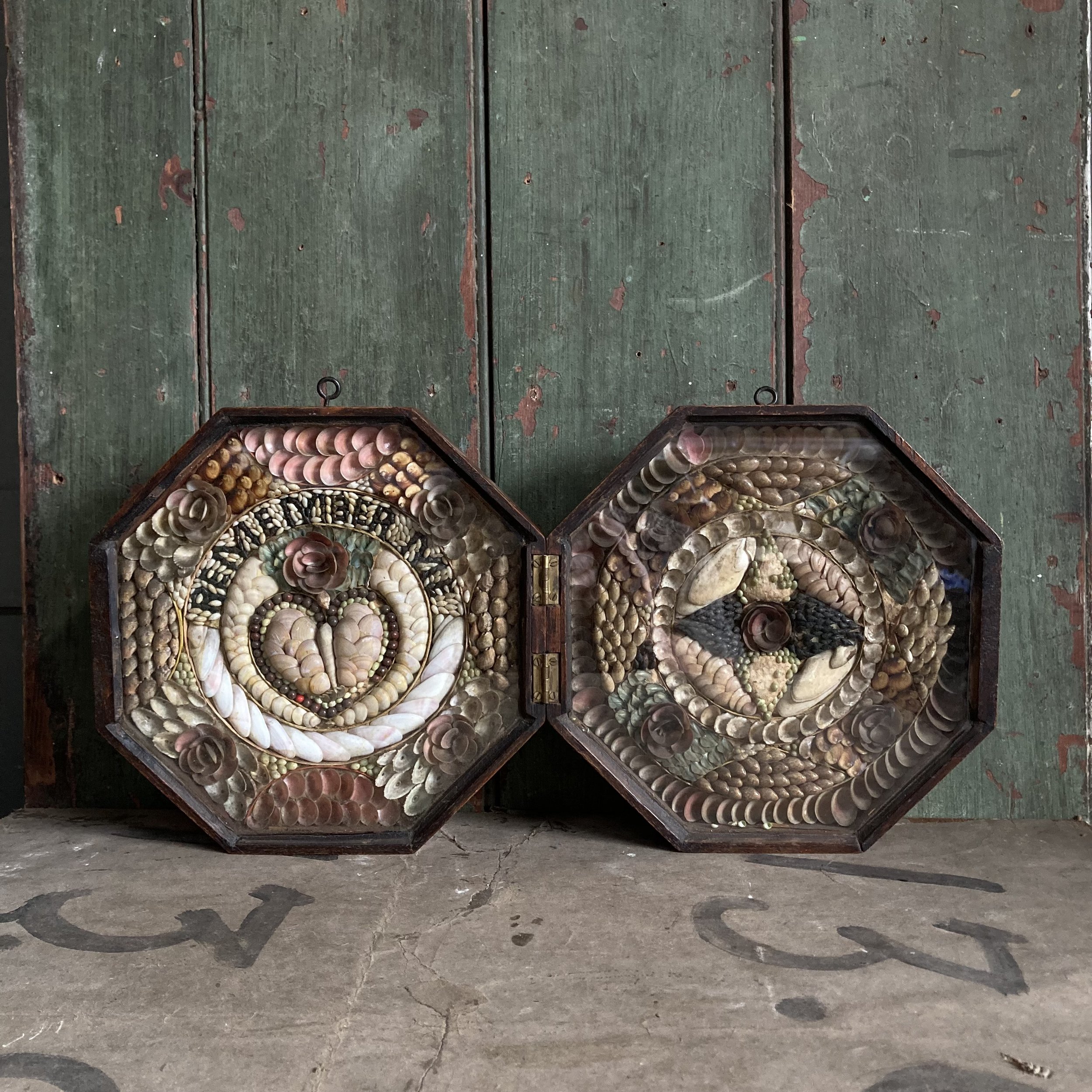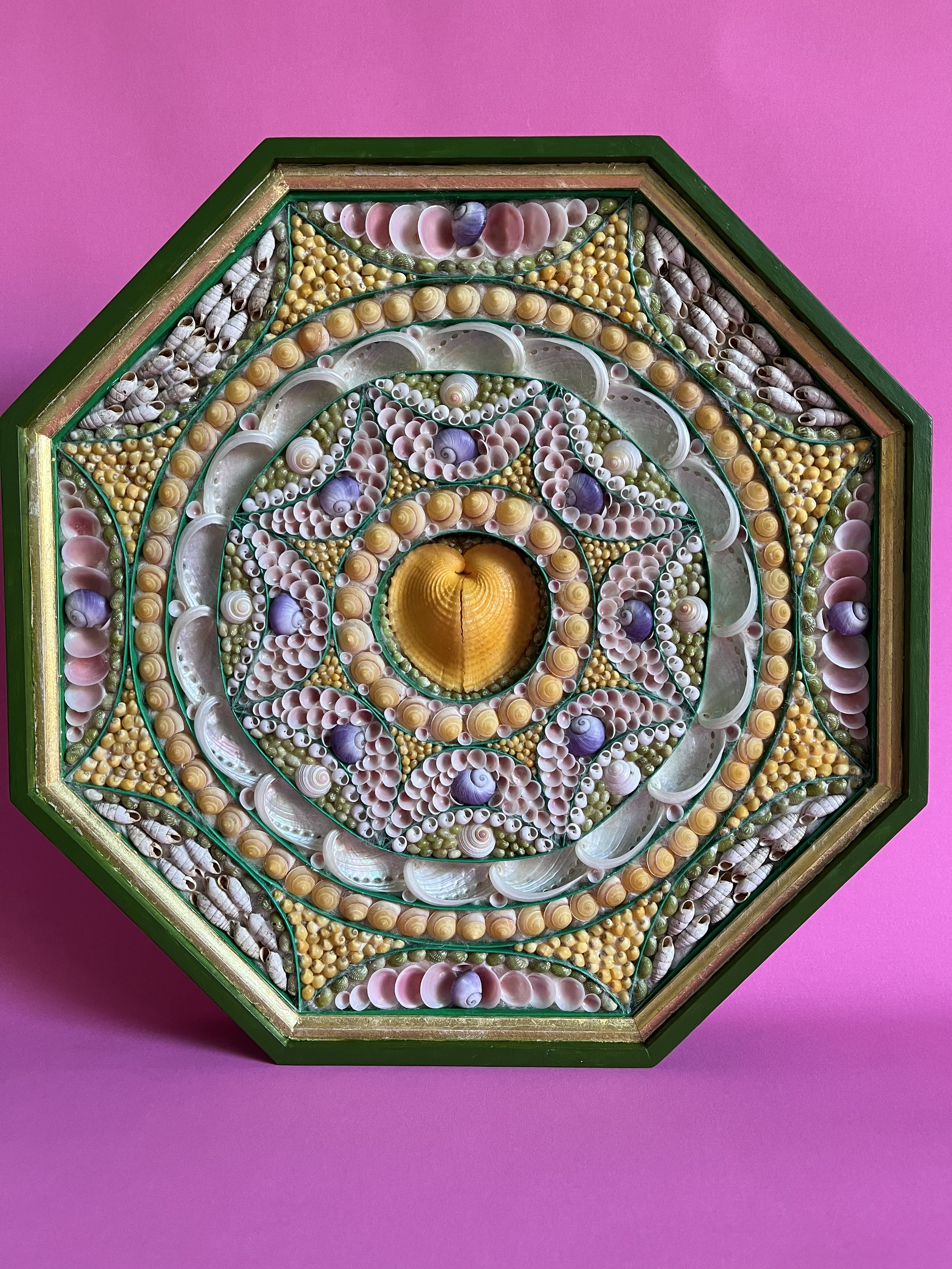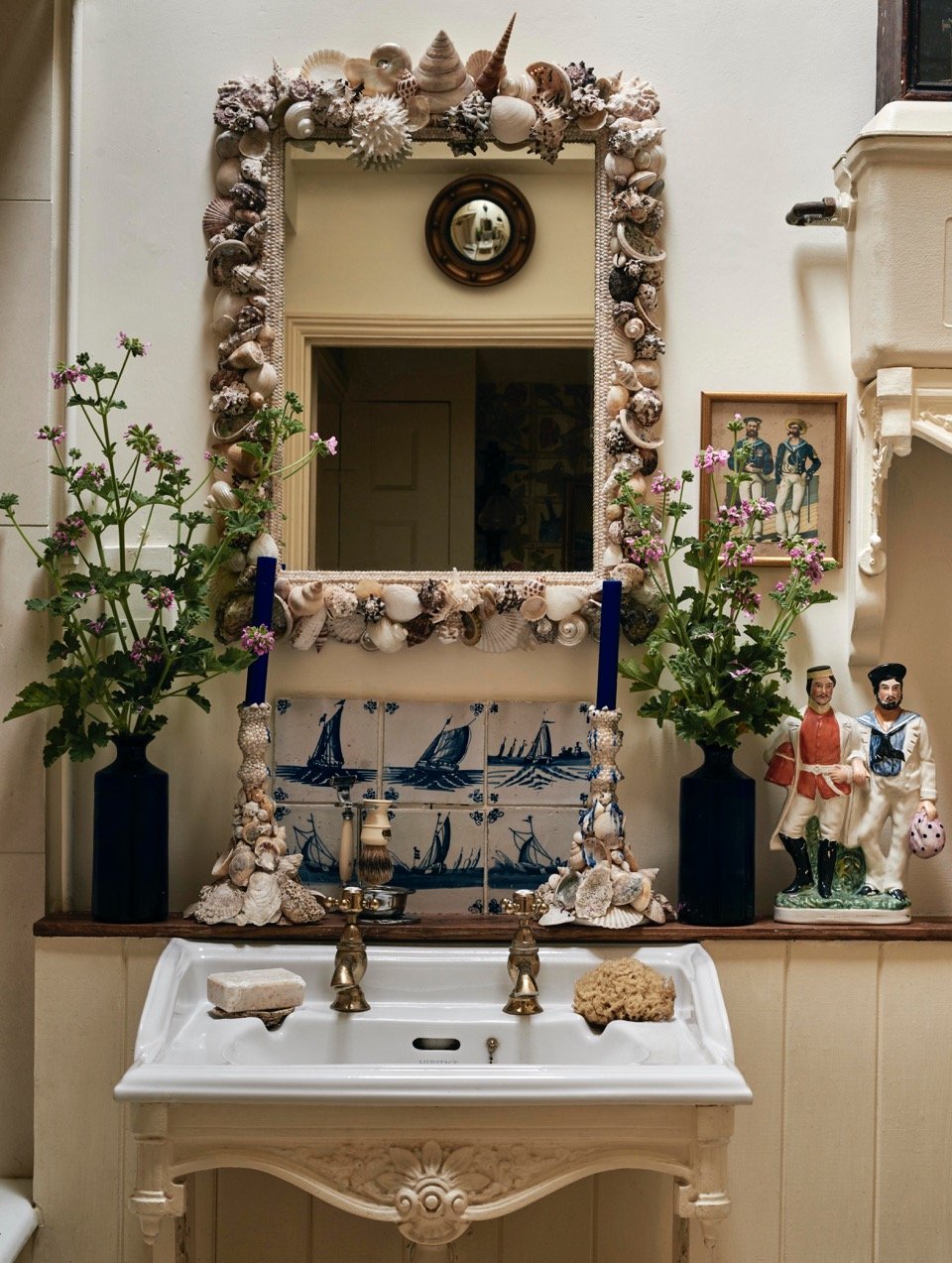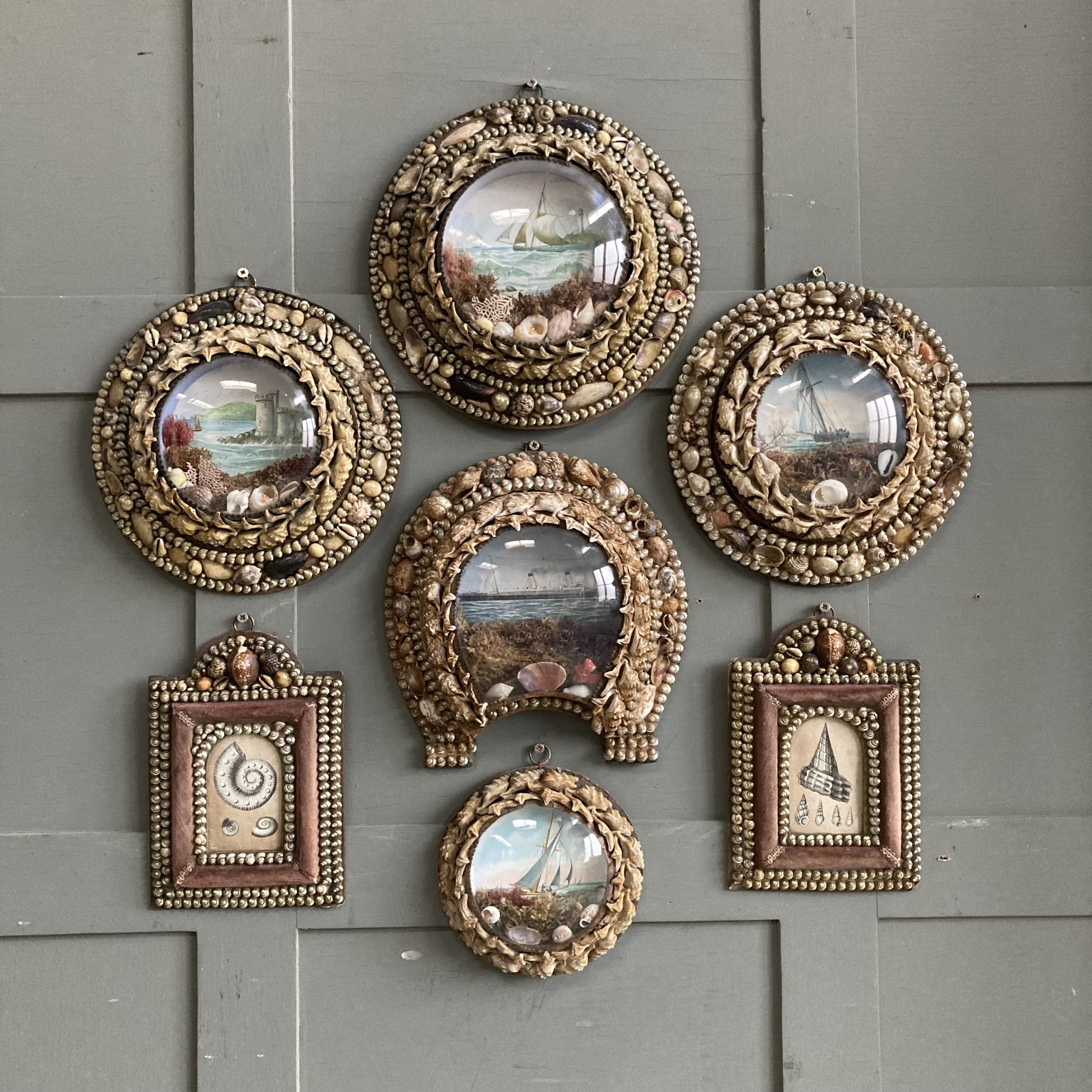Sailor's Valentines for The World of Interiors
THE COCKLES OF MY HEART
Popular 18th- and 19th-century mementos aboard navy and whaling ships, sailor’s valentines are relatively rare today but have perennial appeal among a crop of contemporary makers and shell artists
Inside the museum-like home of Alex Snell is a collection of seashells. The walls are covered with souvenirs, and furniture includes a map chest filled with Victorian shell flowers, adorned with coral-filled domes. Embedded among these treasured possessions is a sailor’s valentine that opens with a lock and key. A collector for over 30 years, Alex lives in Sheringham, north Norfolk, and volunteers at the local Peter Coke Shell Gallery, a gem of a place that is home to over 100 creations by the (late) eponymous owner. A former antique dealer with a shop on the King’s Road, London, Peter used to repair sailor’s valentines in the 1980s, before going on to make his own.
These eight-sided coquillage keepsakes have long held appeal. They were originally bought by sailors when their ships docked in Barbados, a key stopping-off point in the Caribbean on trade routes from the late Georgian era onwards. The shellworks were created by local artisans on the island and retailed principally through the New Curiosity Shop, owned by two English brothers, Benjamin and George Belgrave, from the mid-19th century to the early 20th.
Sailor’s valentine by shell artist Tess Morley
The Victorian habit of collecting and displaying exotic objects brought home by sailors and impressionable travellers fuelled both the industry and no doubt the enthusiasm for the valentines, which comprised hundreds of shells in concentric and geometric patterns, often including sentimental mottos such as ‘Forever Yours’, ‘Home Again’ or ‘Forget-Me-Not’.
Designs traditionally consisted of two octagonal hinged cases – hence the term double valentines. They close so that the two sides, with their glass, would be protected when being brought home by a sailor. Inside the frames, a variety of tiny shells is glued on to cotton batting in intricate patterns – often centred, as the name suggests, on a heart-shaped motif encrusted with seashells, sea urchin spines and mother-of-pearl. The resulting mosaic is exotic and fanciful, and a tribute to the imagination and industry of these seafaring times.
In the bathroom of this gardener’s bothy in Gunton, home to interior designer John Tanner, a shellwork mirror and candlesticks by Carolyn Brookes-Davies take centre stage, complemented by 18th century Delft maritime-themed tiles bought from Richard Scott Antiques in Holt, Norfolk. The 19th century Staffordshire sailors were found on eBay. Photograph: Christopher Horwood
Today, the desire for shellwork lives on. These historic designs are highly sought after, in Britain and the USA, with prices starting from £5,000 for the best early examples. Cornwall-based antique dealer Marc Kitchen-Smith, known as a go-to for decorative maritime pieces, has a regular stock of sailor’s valentines in his catalogue. This includes early originals made in Barbados, as well as later seaside souvenirs from British ports. ‘I’m looking for no later than Edwardian; 1920s and before,’ Marc explains. ‘They need to be of an age as that gives a certain quality. The fact they have been on walls for so long means they acquire a patina that makes them attractive.’
Today, the desire for shellwork lives on. These historic designs are highly sought after, in Britain and the USA, with prices starting from £5,000 for the best early examples. Cornwall-based antique dealer Marc Kitchen-Smith, known as a go-to for decorative maritime pieces, has a regular stock of sailor’s valentines in his catalogue. This includes early originals made in Barbados, as well as later seaside souvenirs from British ports. ‘I’m looking for no later than Edwardian; 1920s and before,’ Marc explains. ‘They need to be of an age as that gives a certain quality. The fact they have been on walls for so long means they acquire a patina that makes them attractive.’
High on romance, high on craft, the decorative boxes are prized by shell collectors, fans of Victoriana and anyone with an appreciation of nature and the handmade. They are rare, however, either to buy or view in a museum, with many locked away in the depths of the Victoria & Albert Museum.
Sussex-based artist Tess Morley created this 13” diameter Valentine using purple snails and curled Spirula spirula rams’ horn shells. These encircle a true heart cockle centrepiece, encased within a painted blue and gilded frame
Interiors influencers such as Alexandra Tolstoy have played a part in their popularity. To mark Valentine’s Day 2023, she collaborated with artist Sarah-Jane Axelby, who created a set of hand-painted sailor’s valentines inspired by the originals Alexandra has in her home.
Decorators such as John Tanner incorporate commissioned shellwork into his elegant interiors. He says: ‘Throughout history, nature has inspired the very best design.’ But it is contemporary artists including Blott Kerr-Wilson, Mel Campion and Carolyn Brookes-Davies whose distinctive artworks grasp the 19th-century shellwork baton and translate it for the modern day. Tess Morley, in particular, is a fan of sailor’s valentines, using the best-quality shells as a material to create geometric patchwork patterns that involve many hours of dedicated tweezer work. ‘I make them because they’re a nice thing for me to do in the studio,’ she says, smiling. ‘I don’t have to go to a site and walk up ladders.’
Tess began her sailor’s valentines in the same way as Peter Coke: learning the technique by restoring old ones. She then went on to make her own. Her recent creations boast colourful frames that feel modern and work well in a contemporary interior – more so than the traditional rosewood or mahogany versions – with shells often recycled from old necklaces. ‘They’re a way of using up tiny little shells, which are hard to get hold of. I love intricate patterns. Detail is my thing, and sailor’s valentines are perfect for that.’



